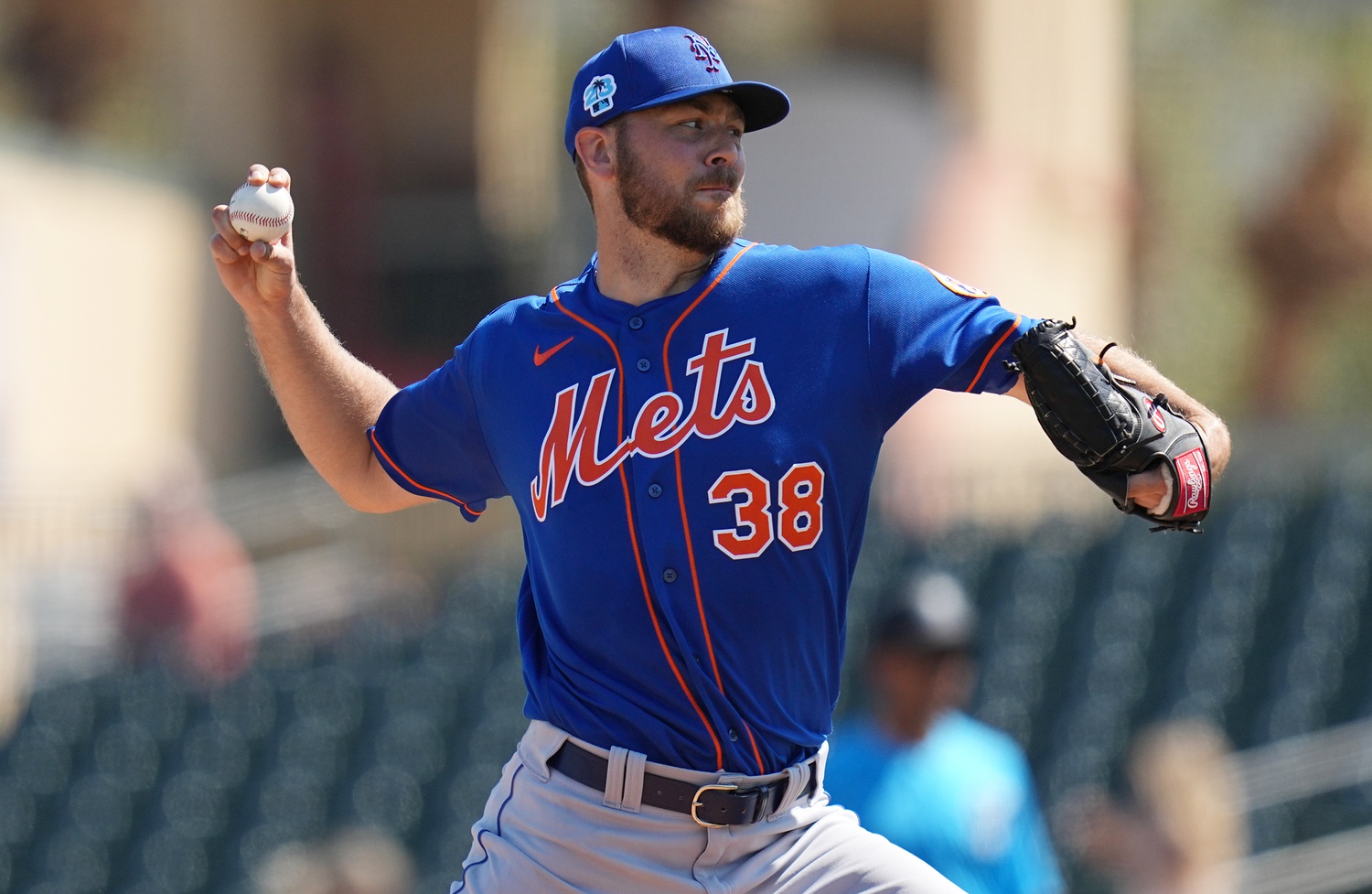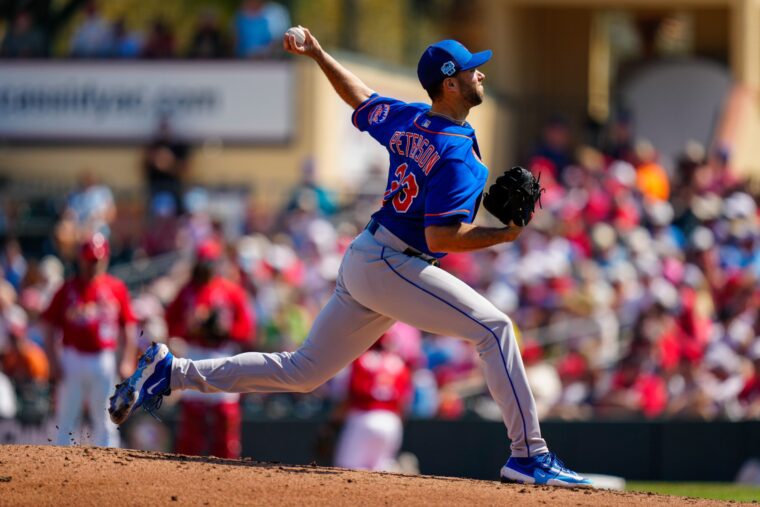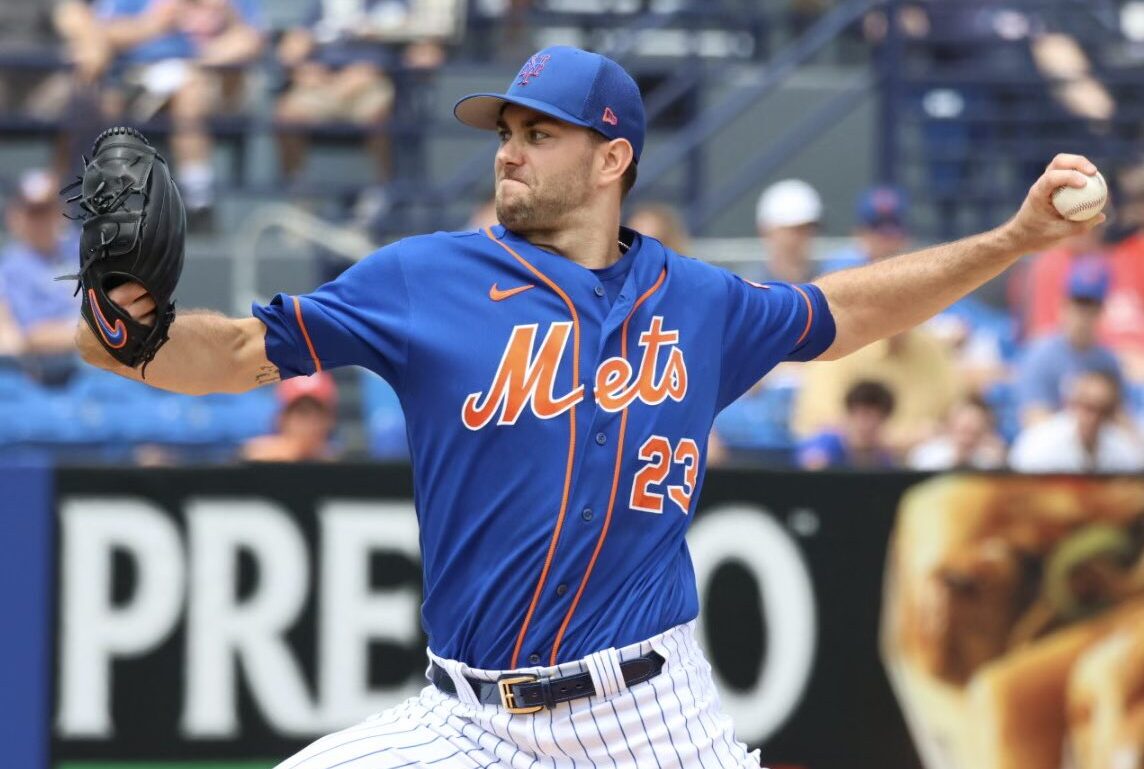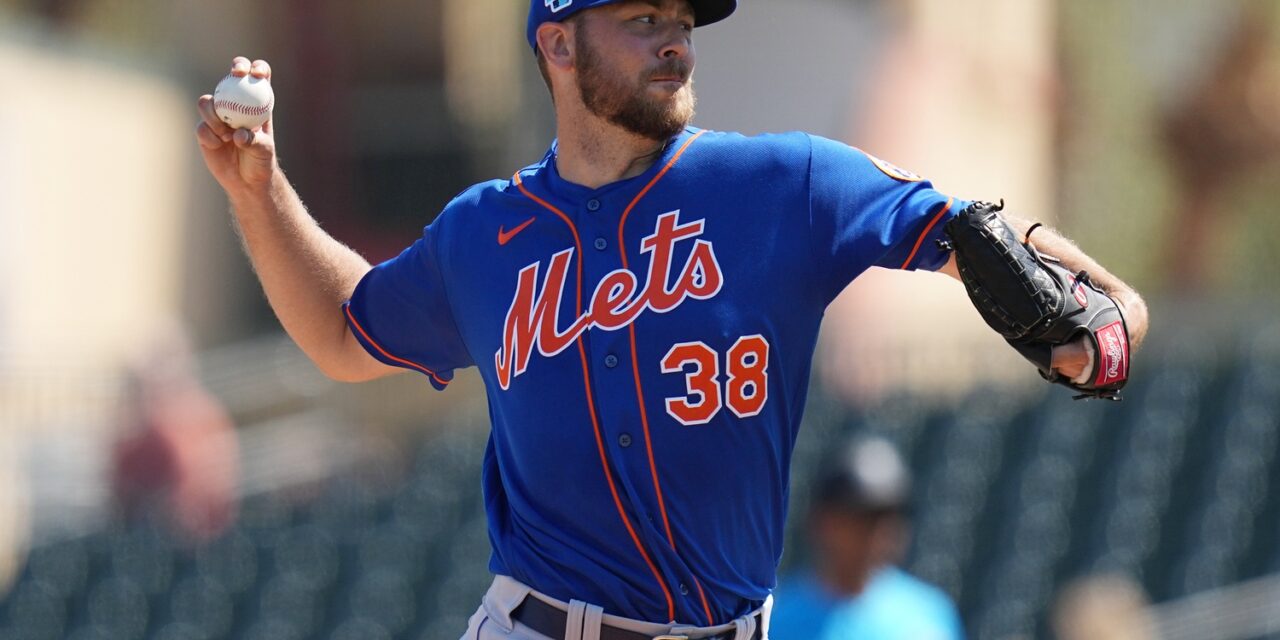
Jim Rassol-USA TODAY Sports
The Mets were fully aware that their starting pitching depth was going to be tested this season. They had hoped, though, that it wouldn’t be quite this soon.
With the news about José Quintana‘s surgery for a stress fracture in his rib, the Mets will now be down a starter until at least July. While not ideal for the team, it presents a golden opportunity for one of the Mets’ younger depth starters to earn a more prominent role in the rotation. David Peterson and Tylor Megill, both contributors to the team in 2022, will use the remaining few weeks of spring training to vie for that slot.
Now, manager Buck Showalter did say that the team will likely begin the season with a six-man rotation. The primary reason is to ease Kodai Senga into pitching in the U.S., as he threw only once a week in Japan. Another reason, though, could be to get an extended look at both Peterson and Megill for if and when the team reverts back to a five-man rotation.
Both players will use spring training and whatever early starts they receive to make their case for the spot. However, each one has a prior major league resumé that can provide context for the more suitable everyday starter. There are also some changes to keep in mind which could sway the decision in one direction or the other.
Pitching Arsenal
According to Baseball Savant, both Peterson and Megill relied on five pitches in 2022, although with different usage rates. The two share the basic four-seam fastball, slider, changeup, and curveball. Peterson throws a sinker, while Megill has a cutter.
Last season, Peterson used his four-seamer 37.9% of the time, slider 29.1%, changeup 16.3%, sinker 11.7%, and curveball 5%. Interestingly, from 2020-22, while his rates of slider, changeup, and curveball use have remained roughly stable, he made some more radical changes with his four-seamer and sinker, inverting them from 2020-21 before switching back in 2022.
In terms of Run Value, Peterson’s best pitch when he is right is his slider. He yielded -6 RV on the pitch in his rookie year, tied with his four-seamer for his best RV, and then gave up -5 in 2022, which was his best pitch result. Unsurprisingly, the slider was the pitch that went bad in Peterson’s difficult 2021 season, as he gave up 5 RV on the pitch with 24.4% usage.
Peterson’s sinker and changeup seem to be consistent minus pitches for him, as he has yielded positive RV in each of his three seasons on both of those pitches. The worst result was 6 RV on his sinker in 2022 with just 11.7% usage.
One of Peterson’s difficulties is that the spin rate on his fastball and curveball are very low by league standards. His fastball spin was in the 15th percentile among pitchers in 2022, and has been almost exactly that through his three-year career. His 2022 curveball was in the 27th percentile in spin rate.
Meanwhile, Megill uses his four-seamer a lot more often than Peterson, hurling it 56.9% of the time in 2022. He complemented the heater with 20.1% slider usage, 18.3% on his changeup, 2.8% on a curveball, and 1.9% on a cutter. His usage rates have been virtually identical in his parts of two seasons with the Mets.
Megill’s changeup has been a minus pitch for him, as thus far, he has yielded 5 and 3 RV on it in his two seasons in the league. His four-seamer and slider have been his best pitches, yielding RV between of -1 or -2 each year.
Megill also doesn’t have great fastball spin, ranking in the 30th and 33rd percentile over two seasons. (He did not throw enough curveballs to qualify for spin rate ranking.)
One very important thing to note about Megill is a dip in fastball speed this spring. He averaged 95.7 mph on his four-seamer in 2022 but it is down to 93.5 mph so far. This is a conscious effort to conserve his energy and be able to pitch deeper into games. Through nine starts in 2022, Megill made it through the sixth inning just twice. Furthermore, Megill believes that his 1.1-mph increase in average fastball velocity from 2021 to 2022 might have caused his shoulder strain last year, increasing the wisdom of slowing it down a bit.
Max Scherzer is also having an impact on Megill. The ace has proselytized far and wide about the benefits of a curveball for right-handed pitchers, dating back to last spring when he encouraged Jacob deGrom to develop the pitch. Scherzer likes throwing a curve to left-handed batters to steal a free strike, and he has also talked to Megill about saving his best pitches for later in the game.
As a result, Megill threw a curveball on 9% of his pitches in his most recent spring outing after having used it just 2.8% of the time last year. He said that he’s been working on developing it and thinks it will help him in the top of the zone. The work he put in is noticeable in his results: a 63-inch vertical break on the pitch, up from an average of 53 inches in 2022 (which was 2% more than the average break on similar pitches).
From an analytical perspective (and common sense), there is a push for pitchers to throw their best pitch more often, regardless of what type of pitch it is. It appears that Megill has gotten the memo, while Peterson could use it.

Rich Storry-USA TODAY Sports
Sabermetrics
Based on an overall body of work in 2022, Peterson had a more successful season than Megill. The lefty put up a 3.83 ERA, 3.94 xERA, 3.64 FIP, 3.31 xFIP, and 1.4 WAR in 105.2 innings pitched. His FIP was 6% better than pitchers when adjusted for park and batters faced, and his ERA was just about average in that context. His 27.8% strikeout rate was in the 79th percentile for pitchers, but his 10.4% walk rate was in the 13th percentile.
Megill’s sample size was smaller than Peterson’s, and a lot of it came in relief at the end of the year. In 47.1 innings pitched, Megill had a 5.13 ERA, 4.31 xERA, 3.77 FIP, 3.35 xFIP, and 0.6 WAR. Although Megill’s ERA was 36% worse than league average when adjusted for context, his FIP was 3% better than average, which is roughly in line with Peterson’s. His 25.5% strikeout rate was not quite as good as Peterson’s but still above the 22.1% average, and his walk rate was better than the 8.1% average at 6.5%.
When you dive deeper into the rate numbers, though, you find two pitchers who give up a significant amount of hard contact. Although Peterson’s xSLG was in the 61st percentile, his hard hit rate (21st), average exit velocity (18th), and barrel rate (41st) explain why his BABIP was worse than average at .313.
Megill, too, was quite a bit worse than league average in barrel rate (10.1% vs. 6.7%), launch angle (13.5% vs. 12.1%), sweet spot rate (36.3% vs. 33%), and average exit velocity (89.2 vs. 88.4). His BABIP was .305. Surprisingly, his hard-hit rate was slightly better than league average at 34.8% (vs. 35.8%).
When it comes to home runs, though, there was a large discrepancy. Peterson allowed 0.94 HR/9 last season, while Megill’s number was very high at 1.33. This is in part due to the three homers Megill allowed on just 145 changeups thrown.
Mets Defensive Fit
Right now, the Mets’ outfield is stronger defensively than their infield. Though the double-play pair of Francisco Lindor and Jeff McNeil is among the strongest in baseball, Pete Alonso and Eduardo Escobar (or Brett Baty) leave much to be desired defensively, combining for -14 OAA in 2022. Furthermore, the Mets were among the leaders in defensive shifts last season, making the ban possibly affect their infield defense more than other teams.
Perhaps this points to an advantage for Megill over Peterson, as the latter profiles as more of a fly ball/line drive pitcher than average, while the former leans toward groundball/line drive. In 2022, Megill’s groundball/flyball/line drive rates were 42.2%/28.1%/23.0%, compared to Peterson’s 49.8%/17.9%/27.1%; the league averages are 44.9%/23.1%/25.0%.
However, at the cavernous Citi Field, there is more room for bad things to happen on fly balls and line drives. Flyball pitchers get some help in the home run department at Citi, but they also can get hurt by barreled balls. Both of these pitchers gave up more barrels than average, but Peterson’s average launch angle was significantly lower than Megill’s (8.1 vs. 13.5).
Other Factors
As stated earlier, Megill is trying to add to his pitch arsenal and keep his velocity controlled to pitch deeper into games. Peterson has had a similar problem; he finished the sixth inning in only four of his 19 starts last season and often averaged close to or more than 20 pitches per inning. This is mainly due to his high walk rate.
However, there is one pivotal difference between the two pitchers: Peterson did not injure his arm when trying to stretch out as a starter. Megill’s lower velocity has profiled well so far this offseason, but it also may take something off his four-seamer. Peterson, meanwhile, averaged 93.7 mph on his fastball in 2022 (just about the league average) and produced his results with that speed.
If Megill can use the curveball successfully and save his best stuff for last, he may have more potential as a pitcher than Peterson. We saw some of the possibilities early in 2022 when he went 4-0 with a 1.93 ERA in April. However, there are question marks following his injuries.
Another factor to keep in mind is handedness. Quintana was set to be the lone southpaw in the Mets’ rotation, and he allowed a .219/.286/.271/.557 to lefties last season. The lefty Peterson had a line of .177/.263/.377/.640 against left-handed batters, while Megill was at .293/.343/.495/.838 against lefties (he actually faced more left-handed batters than right-handers). The Mets may want to maintain that platoon advantage in their rotation.
So far in spring training, both pitchers have performed well. Peterson pitched four scoreless innings in his latest outing and has yet to allow a run, pitching to an impressive 0.50 WHIP. Megill also hasn’t allowed a run and went four scoreless in his last performance.

Photo by Ed Delany of MetsmerizedOnline
Bottom Line
Both pitchers struggled down the stretch last season: Peterson in his final cameos as a reliever/starter, and Megill in his return from injury as a reliever. Both have questions about durability, reproducibility of positive results given the amount of hard contact made against them, and “stuff.”
I don’t know if there’s a clear right or wrong answer to who should start. Peterson strikes out somewhat more batters than Megill, but Megill keeps his walk rate lower. Both pitchers get hit hard at times, though Peterson’s contact tends to come on the ground more often than Megill’s. Megill gave up more homers than Peterson.
Ultimately, if I had to choose one, I’d go with the former first-round pick who has two solid seasons under his belt. Peterson did everything the Mets asked of him last season and did not complain even when they shuttled him back and forth between the minors, majors, and bullpen. He pitched really well for most of 2022 and held down the fort when the team’s aces were injured.
Is Peterson going to be a star? No. But he deserves the chance to show what he can do with some consistency and time to refine his craft at the major league level. Megill will undoubtedly get opportunities throughout the season, regardless.
With a lack of complete clarity in the data, the more consistent pitcher wins, and that’s Peterson.
















